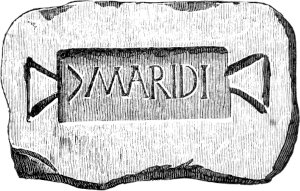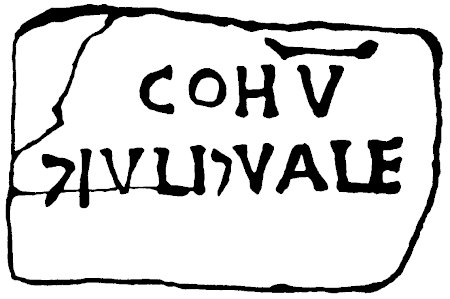Introduction
The bulk of the inscriptions from this sector derive from 19th- and 20th-century excavation and 20th-century consolidation work on the curtain wall, mostly in the region of Walltown Crags.
Inventory
RIB 1754: coh(ortis) V / c(enturia) Sexti Proc(uli) (‘Fifth Cohort, century of Sextus Proculus (built this)’). Centurial stone found before 1909 near Milecastle 44. Source: RIB I p.549

RIB 1755
RIB 1755: coh(ortis) III [c(enturia)] / Seni[lis] (‘Third Cohort, century of Senilis’). Centurial stone found 1904 in debris near Milecastle 44. Source: RIB I p.550
RIB 1756: coh(ortis) VII / [c(enturia) ..]XI[..]IAN[.] (‘Seventh Cohort, century of (…)’). Centurial stone found before 1732 at Allollee farm cow shed. Source: RIB I p.550

RIB 1757
RIB 1757: coh(ortis) VIII / c(enturia) Secci (‘Eighth cohort, the century of Seccius (built this)’). Centurial stone found in Wall debris near Milecastle 44. Source: RIB I p.550

RIB 1758
RIB 1758: c(enturia) Maxi(mi) (‘the century of Maximus (built this)’). Centurial stone found in Wall debris near Milecastle 44. Source: RIB I p.550
RIB 1759: co[h(ortis) (‘… cohort …’). Centurial stone found before 1732 at Allolee farm. Source: RIB I p.550

RIB 1760
RIB 1760: c(enturia) Mari Dex(tri) (‘the century of Marius Dexter (built this)’). Centurial stone found before 1873 near the Wall, then built into Allolee farm. Source: RIB I p.550

RIB 1761
RIB 1761: c(enturia) Valeri / Veri (‘the century of Valerius Verus (built this)’). Centurial stone found before 1873 near the Wall, then built into Allolee farm. Source: RIB I p.551
RIB 1762: [Leg(ionis)] XX V(aleriae) V(ictricis) / [c(o)h]o(rtis) X / [|(centuria) Iul]i Flo/[ren]tini (‘the Twentieth Legion Valeria Victrix, Tenth Cohort, century of Iulius Florentinus (built this)’). Centurial stone found in 1892 at Mucklebank Turret. Source: RIB I p.551

RIB 1763
RIB 1763: coh(ortis) I c(enturia) / Fl(avi) Cre(scentis) (‘First Cohort, century of Flavius Crescens (built this)’). Centurial stone found 1892 on the SE corner of Turret 44b. Source: RIB I p.551

RIB 1764
RIB 1764: coh(ortis) VIII / c(enturia) Secci (‘Eighth Cohort, century of Seccus’). Centurial stone found before 1873 at Low Town farm. Source: RIB I p.551
RIB 1765: c(enturia) Mu/nati / Max(imi) (‘century of Munatius Maximus (built this)’). Centurial stone found before 1732 near Walltown. Now lost. Source: RIB I p.552
RIB 1766: coh(ortis) V / c(enturia) Val(eri) / Maximi (‘Fifth Cohort, the century of Valerius Maximus (built this)’). Centurial stone found 1807 at Walltown. Source: RIB I p.552
RIB 1767: …v(otum)] / s(olvit) l(ibens) l(aetus) m(erito) (‘gladly, willingly, and deservedly fulfilled a vow’). Altar found before 1716 near Walltown. Now lost. Source: RIB I p.552
RIB 1768: coh(ortis) III / |(centuria) Socelliana (‘Third Cohort, the former century of Socellius (built this)’). Centurial stone found in 1757, probably near Turret 44b. Now lost. Source: RIB I pp.552-3
RIB 1769: coh(ortis) III / c(enturia) Ferroni / Vegeti (‘Third Cohort, the century of Ferronius Vegetus (built this)’). Centurial stone found 1939 E of Walltown quarry. Source: RIB I p.553
RIB 1770: c(enturia) Cl(audi) Au/gus[t]a(ni) (‘the century of Claudius Augustanus (built this)’). Centurial stone found 1939 E of Walltown quarry. Source: RIB I p.553
RIB 1771: c(enturia) Mar/i Dext(ri) (‘the century of Marius Dexter (built this)’). Centurial stone found 1939 E of Walltown Quarry. Source: RIB I p.553
RIB 1772: c(o)ho(rtis) VI c(enturia) / Lepidiana (‘Sixth Cohort, the former century of Lepidius (built this)’). Centurial stone found in 1948 E of Turret 45b. Source: RIB I p.553

RIB 1773
RIB 1773: coh(ortis) III / c(enturia) [IIOIIV] (‘Third Cohort, the century of… (built this)’). Centurial stone found 1883 near Turret 45b. Source: RIB I p.553

RIB 1774
RIB 1774: coh(ortis) V / c(enturia) Iuli Vale(ntis) (‘Fifth Cohort, the century of Iulius Valens (built this)’). Centurial stone found 1885 between Turret 45a and 45b. Source: RIB I p.553
RIB 3377: coh(ortis) V / c(enturia) Val(erii) / Rufini (‘Fifth Cohort, the century of Valerius Rufinus (built this)’). Centurial stone found 1980 near Turret 45a. Source: RIB III p.353
RIB 3378: leg(ionis) XX V(aleriae) V(ictricis) / c(o)ho(rtis) X / c(enturia) Fl(avi) Nor/ici (‘From the Twentieth Legion, Fifth Cohort, the century of Flavius Noricus (built this)’). Centurial stone found 7.63m W of Turret 45a. Source: RIB III p.354
RIB 3379: coh(ortis) VI / c(enturia) Caledo(ni) / Secundi (‘Sixth Cohort, the century of Caledonius Secundus (built this)’). Centurial stone found 1959 47.28m W of Turret 45a, fallen from S face. Source: RIB III pp.354-5
RIB 3380: X (’10’). Building stone found 1987 96m W of Turret 45a in situ on the N face. Source: RIB III p.355
RIB 3381: X (’10’). Building stone found 1987 98m W of Turret 45a in situ on the N face. Source: RIB III p.355
RIB 3382: coh(ortis) I c(enturia) / Libonis (‘First Cohort, the century of Libo’). Building stone found 1987 95.16m W of Turret 45a in rubble from the S face. Source: RIB III p.356
RIB 3383: c(enturia) Ulpi Vo/lusiini (‘the century of Ulpius Volusiinus (built this)’). Centurial stone found 1960 96.28m W of Turret 45a in rubble on N side of Wall. Source: RIB III p.356
RIB 3384: VIII (‘8’). Building stone found 1960 96.28m W of Turret 45a in rubble on N side of Wall. Source: RIB III pp.356-7
RIB 3385: c(enturia) Caledon(i) / Secundi (‘the century of Caledonius Secundus (built this)’). Centurial stone found 1959 137.4m W of Turret 45a. Source: RIB III p.358
RIB 3386: coh(ortis) III / c(enturia) Maximi (‘Third Cohort, the century of Maximus (built this)’). Centurial stone found 1960 between Turrets 45a and b. Source: RIB III p.358
RIB 3387: coh(ortis) III / c(enturia) Max(imi) Ter(e)n(ti) (‘Third Cohort, the century of Maximus Terentius (built this)’). Centurial stone found 1960 151m W of Turret 45a. Source: RIB III p.359

RIB 3388
RIB 3388: coh(ortis) III / c(enturia) O[…] (‘Third Cohort, the century of O(…) (built this)’). Centurial stone found 1960 160m W of Turret 45a. Source: RIB III p.360
RIB 3389: c(enturia) Mari / Dext(ri) (‘the century of Marius Dexter (built this)’). Centurial stone found 1960 245.2m W of Turret 45a fallen from S face. Source: RIB III p.360
RIB 3390: c(enturia) Val(eri) Veri (‘the century of Valerius Verus (built this)’). Centurial stone found 1960 287.3m W of Turret 45a fallen from S face. Source: RIB III p.361
RIB 3391: coh(ortis) II / c(enturia) Laetiani (‘Second Cohort, the century of Laetianus (built this)’). Centurial stone found 1960 295.5m W of Turret 45a. Source: RIB III p.361
Analysis
These inscriptions almost exclusively derive from the building work of the Twentieth Legion and this is reflected in the number of inscriptions with very detailed geolocational information. The issue of the allocation of centurial inscriptions has been dealt with elsewhere, but the sample provided by this and subsequent consolidated sections provides a detailed insight into the cohorts and centuries of the Twentieth Legion working here.














You must be logged in to post a comment.